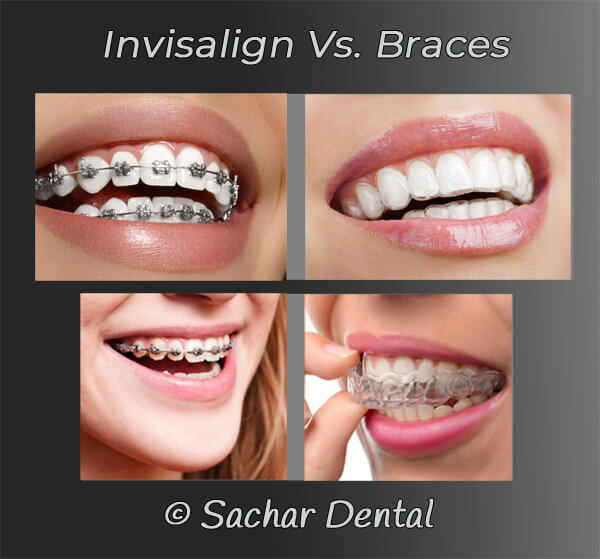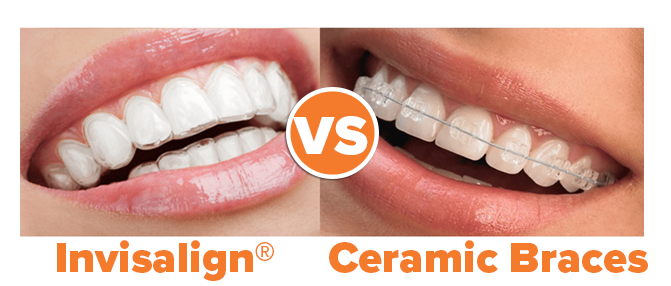What to Anticipate Throughout Your Invisalign Journey: A Comprehensive Review
What to Anticipate Throughout Your Invisalign Journey: A Comprehensive Review
Blog Article
Invisalign vs. Traditional Braces: Which Alternative Is Right for You?
When considering orthodontic treatment, the option in between Invisalign and typical dental braces provides a number of vital factors that merit cautious examination. Invisalign uses a discreet alternative with removable aligners, while conventional dental braces give an extra visible yet efficient option for serious imbalance. Each alternative incorporates distinctive benefits and drawbacks related to aesthetic appeals, convenience, treatment duration, and cost. Comprehending these nuances is vital for making a notified choice that lines up with your personal choices and lifestyle. The question remains: which option will best satisfy your orthodontic requirements and expectations?
Review of Therapy Choices

In comparison, conventional dental braces consist of steel braces and wires that are bound to the teeth. This method uses continuous pressure gradually to achieve positioning. While reliable for complex orthodontic problems, typical braces require routine gos to for modifications and can pose challenges in preserving dental hygiene due to the problem of cleaning up about wires and brackets.
Both options have their values, and the choice commonly depends upon details dental problems, lifestyle preferences, and individual conformity. Inevitably, speaking with an orthodontic expert is vital for identifying the most appropriate treatment strategy tailored to individual requirements. Recognizing the subtleties of each alternative can significantly affect the total success of orthodontic treatment.
Visual Considerations
A significant factor affecting the option in between Invisalign and traditional dental braces is the aesthetic appeal each therapy provides. Invisalign aligners are crafted from clear plastic, making them virtually unseen when worn.
In comparison, typical dental braces consist of steel brackets and cables, which can be extra recognizable. While improvements in orthodontic technology have actually led to the growth of smaller braces and colored elastics, traditional braces still keep a more obvious profile. For some people, the exposure of dental braces may hinder them from seeking needed therapy.
Eventually, the choice in between Invisalign and traditional braces might hinge on personal choices regarding appearances. Individuals that prioritize discretion usually favor Invisalign, while those that are less concerned concerning visibility may go with typical braces. Comprehending the visual implications of each choice is critical for making an informed decision that straightens with one's way of living and preferences.
Convenience and Convenience

In regards to ease, Invisalign aligners are detachable, allowing clients to enjoy their favored foods without limitation and maintain optimal dental health. Brushing and flossing are simplified, as the aligners can be taken out throughout these routines, whereas typical dental braces call for cautious steering around cords and brackets.
In contrast, standard dental braces necessitate normal adjustments, making them less hassle-free for those with hectic timetables. In general, the convenience and convenience of Invisalign make it an attractive selection for many individuals looking for orthodontic treatment.
Therapy Period and Effectiveness
While both Invisalign and typical dental braces work in remedying oral misalignments, the period of therapy can vary dramatically between both choices. Generally, Invisalign therapy can take anywhere from 12 to 18 months, depending on the complexity of the situation. The clear aligners function by progressively shifting teeth into their desired settings, and normal follow-ups with an orthodontist help guarantee development stays on course.
On the other hand, typical dental braces frequently need a longer dedication, generally varying from 18 webpage months to 3 years. This results from their set nature and using braces and cords, which can be much more effective for serious misalignments and complex cases (Invisalign). The therapy effectiveness of conventional braces is well-documented, as they allow for accurate modifications and greater control over tooth motion
Ultimately, the selection in between Invisalign and standard braces may hinge on both the awaited therapy period and the particular dental concerns handy. Consulting with an orthodontist is essential, as they can offer tailored recommendations based upon private needs, ensuring the picked approach straightens with preferred durations and results.
Cost Contrast and Insurance Policy Choices
Cost plays a significant duty in the decision-making procedure for individuals taking into consideration orthodontic therapy, whether opting for Invisalign or typical braces. Typically, the price of Invisalign varieties from $3,000 to $8,000, while conventional dental braces normally cost in between $2,000 and $6,000. Elements influencing these prices include the complexity of the situation, the duration of treatment, and geographical location.
Several dental insurance coverage strategies provide partial protection for orthodontic therapies, however the specifics can vary commonly. Generally, standard dental braces might be more frequently covered by insurance coverage strategies contrasted to Invisalign, which some insurers categorize as a cosmetic procedure.
Furthermore, numerous orthodontic methods supply flexible payment plans, making both treatment choices much more obtainable. Patients need to ask about possible funding alternatives and discounts for in advance repayments. Reviewing the complete price, consisting of insurance policy advantages and layaway plan, is crucial for making an educated choice that straightens with both visual preferences and budget plan considerations.

Final Thought
In summary, the option in between Invisalign and traditional braces rests on numerous factors, including why not try this out visual choices, convenience, treatment duration, and cost. Invisalign supplies a very discreet, removable choice that helps with oral health and nutritional versatility, while conventional braces might be preferable for complex oral problems and typically come at a reduced cost point. Ultimately, assessment with an orthodontist is necessary to evaluate individual conditions and figure out the most ideal therapy option for attaining optimum oral alignment.
When considering orthodontic therapy, the choice in between Invisalign and conventional dental braces provides several important factors that warrant careful examination.Comparing Invisalign and typical braces discloses distinct therapy choices for orthodontic adjustment.While both Invisalign and traditional braces are effective in remedying dental misalignments, the period of therapy can differ substantially in between the 2 choices.Price plays a significant function in the decision-making procedure for individuals taking into consideration orthodontic treatment, whether choosing for Invisalign or traditional braces.In recap, the choice between Invisalign and standard dental braces pivots on numerous variables, consisting of visual choices, convenience, therapy period, and price.
Report this page